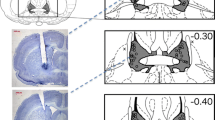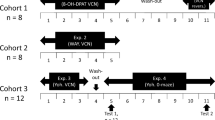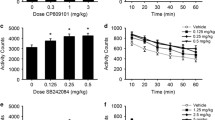Abstract
Rats tested for 1 h in the Behavioral Pattern Monitor (BPM) after injection of the mixed serotonergic agonistd-lysergic acid diethylamide (LSD) exhibit a behavioral profile similar to that produced by various hallucinogenic 5HT-2 agonists. The characteristic effects of the hallucinogens include suppression of locomotor and exploratory behavior and a preferential decrease in entries into the center of the BPM during the initial half of the test session. After LSD, the initial suppression of responding is followed by a subsequent increase in locomotor activity that is not observed with other serotonergic agonists. In the present studies, the 5HT-1 andβ-adrenergic antagonistd,1-propranolol and the 5HT-2 antagonist ritanserin were administered individually or in combination prior to the acute administration of LSD to test for the involvement of these receptor subtypes in the mediation of the effects of LSD in the BPM paradigm. Propranolol (20 mg/kg) abolished the initial suppression of activity induced by 60 µg/kg LSD without affecting the subsequent increase in locomotion. Conversely, 2.0 mg/kg ritanserin failed to block the initial suppressive effects of 60 or 120 µg/kg LSD, but attenuated the LSD-induced increases in activity during the second half of the session. The combination of propranolol and ritanserin prevented both these effects of LSD. By contrast, the more selective 5HT-2 agonist 2,5-dimethoxy-4-iodoamphetamine (DOI) (0.27 mg/kg) produced an initial suppression of activity in the BPM that was blocked by 2.0 mg/kg ritanserin and was not followed by a subsequent increase in activity. These findings suggest that the initial suppressive effects of LSD in the BPM paradigm are dissociable from the subsequent increases in locomotion and that the two effects are mediated via different serotonergic orβ-adrenergic receptors.
Similar content being viewed by others
References
Adams LM, Geyer MA (1982) LSD-induced alterations of locomotor patterns and exploration in rats. Psychopharmacologia 77:179–185
Adams LM, Geyer MA (1985a) A proposed animal model for hallucinogens based on patterns of exploration in rats. Behav Neurosci 5:881–900
Adams LM, Geyer MA (1985b) Effects of DOM and DMT in a proposed animal model of hallucinogenic activity. Prog Neuropsychopharm Biol Psychiatry 9:121–132
Adams LM, Geyer MA (1985c) Patterns of exploration in rats distinguish lisuride from lysergic acid diethylamide. Pharmacol Biochem Behav 23:461–468
Brawley P, Duffield IC (1972) The pharmacology of hallucinogens. Pharmacol Rev 24:31–66
Colpaert FC, Meert TF, Niemegeers CJE, Janssen PAJ (1985) Behavioral and 5-HT antagonist effects of ritanserin: a pure and selective antagonist of LSD discrimination in rat. Psychopharmacology 86:45–54
Dixon A (1968) Evidence of catecholamine mediation in the ‘aberrant’ behaviour induced by lysergic acid diethylamide (LSD) in the rat. Experientia 24:743–747
Dixon WJ (1988) BMDP Statistical Software Manual. University of California Press, Los Angeles
Dolphin A, Enjalbert A, Tassin JP, Lucas M, Bockaert J (1978) Direct interaction of LSD with centralβ-adrenergic receptors. Life Sci 22:345–352
Evenden JL, Angeby-Moller K (1990) Effects of 8-hydroxy-2-(di-n-propylamine)tetralin (8-OH-DPAT) on locomotor activity and rearing of mice and rats. Psychopharmacology 102:485–491
Geyer MA, Light RK (1979) LSD-induced alterations of investigatory responding in rats. Psychopharmacology 65:41–47
Geyer MA, Peterson LR, Rose GJ, Horwitt DD, Light RK, Adams LM, Zook JA, Hawkins RL, Mandell AJ (1978) The effects of lysergic acid diethylamide and mescaline-derived hallucinogens on sensory-integrative function: Tactile startle. J Pharmacol Exp Ther 207:837–847
Geyer MA, Peterson LR, Rose GJ, Horwitt DD, Light RK, Adams LM, Zook JA (1979) A characteristic effect of hallucinogens on investigatory responding in rats. Psychopharmacology 65:35–40
Geyer MA, Gordon J, Adams LM (1985) Behavioral effects of xylamine-induced depletions of brain norepinephrine: interaction with LSD. Pharmacol Biochem Behav 23:619–625
Geyer MA, Russo PV, Masten VL (1986) Multivariate assessment of locomotor behavior: pharmacological and behavioral analyses. Pharmacol Biochem Behav 25:277–288
Glennon RA, Titeler M, McKenney JD (1984) Evidence for 5-HT2 involvement in the mechanism of action of hallucinogenic agents. Life Sci 35:2505–2511
Glennon RA, McKenney JD, Lyon RA, Titeler M (1986a) 5HT-1 and 5HT-2 binding characteristics of 1-(2,5-dimethoxy-4-bromophenyl)-2-aminopropane analogues. J Med Chem 29:194–199
Glennon RA, Titeler M, Young R (1986b) Structure-activity relationships and mechanism of action of hallucinogenic agents based on drug discrimination and radioligand binding studies. Psychopharmacol Bull 22:953–958
Gold LH, Koob GF, Geyer MA (1988) Stimulant and hallucinogenic behavioral profiles of 3,4-methylenedioxymethamphetamine (MDMA) and N-ethyl-3,4-methylenedioxyamphetamine (MDE). J Pharmacol Exp Ther 247:547–555
Hoyer D (1988) Molecular pharmacology and biology of 5HT-1C receptors. TIPS 9:89–94
Isbell H, Logan CR (1957) Studies on LSD. II. Effects of chlorpromazine, azacyclonol and reserpine on the intensity of the LSD-reaction. Arch Neurol Psychiatry 77:350–358
Jacobs BL (1978) Dreams and hallucinations: a common mechanism mediating their phenomenological similarities. Neurosci Biobehav Reviews 2:59–69
Janssen PA (1982) The pharmacology of specific, pure and potent serotonin 5HT2 or S2 antagonists. In: Yoshida H, Hagihara Y, Ebashi S (eds) Advances in pharmacology and therapeutics III. Pergamon, Oxford, vol. 4, pp 21–33
Janssen PA, Laduron PM (1985) Receptor-binding properties in vitro and in vivo of ritanserin: a very potent and long acting serotonin-S2 antagonist. Mol Pharmacol 27:600–611
Linken A (1971) Propranolol for LSD-induced anxiety states. Lancet 6:1039–1040
Lyon RA, Titeler M, Seggel MR, Glennon RA (1988) Indolealkylamine analogs share 5-HT2 binding characteristics with phenylalkylamine hallucinogens. Eur J Pharmacol 145:291–297
Mandell A, Geyer MA (1976) Hallucinogens: chemical and physiological. In: Grenell R, Gabay S (eds) Biological foundations of psychiatry. Raven Press, New York, pp 729–756
Mittman SM, Geyer MA (1989) Effects of 5HT-1A agonists on locomotor and investigatory behaviors in rats differ from those of hallucinogens. Psychopharmacology 98:321–329
Oberlander C, Demassey Y, Verdu A, Van de Velde D, Bardelay C (1987) Tolerance to the serotonin 5-HT1 agonist RU 24969 and effects on dopaminergic behaviour. Eur J Pharmacol 139:205–214
Pierce PA, Peroutka SJ (1989) Hallucinogenic drug interactions with neurotransmitter receptor binding sites in human cortex. Psychopharmacology 97:118–122
Pietrowicz D, Kocur J, Proczynski (1978) The effects of LSD and propranolol on the motor activity in rabbits. Acta Physiol Pol 29:531–535
Sadzot B, Baraban JM, Glennon RA, Lyon RA, Leonhardt S, Jan C-R, Titeler M (1989) Hallucinogenic drug interactions at human brain 5-HT2 receptors: implications for treating LSD-induced hallucinogenesis. Psychopharmacology 98:495–499
Sanders-Bush E, Breeding M (1988) Putative 5HT-2 antagonists block serotonin 5HT-1C receptors in the choroid plexus. J Pharmacol Exp Ther 247:169–173
Sanders-Bush E, Burris KD, Knoth K (1988) Lysergic acid diethylamide and 2,5-dimethoxy-4-methylamphetamine are partial agonists at serotonin receptors linked to phosphoinositide hydrolysis. J Pharmacol Exp Ther 246:924–928
Schmidt AW, Peroutka SJ (1989) 5-Hydroxytryptamine receptor “families”. FASEB J 3:2242–2249
Segal DS, Geyer MA (1985) Animal models of psychopathology. In: Judd LL, Groves PM (eds) Psychobiological foundations of clinical psychiatry. Lippincott, Philadelphia, pp 1–14
Titeler M, Lyon RA, Glennon RA (1988) Radioligand binding evidence implicates the brain 5-HT2 receptor as a site of action for LSD and phenylisopropylamine hallucinogens. Psychopharmacology 94:213–216
Wing LL, Tapson GS, Geyer MA (1990) 5HT-2 mediation of acute behavioral effects of hallucinogens in rats. Psychopharmacology 100:417–425
Author information
Authors and Affiliations
Rights and permissions
About this article
Cite this article
Mittman, S.M., Geyer, M.A. Dissociation of multiple effects of acute LSD on exploratory behavior in rats by ritanserin and propranolol. Psychopharmacology 105, 69–76 (1991). https://doi.org/10.1007/BF02316866
Received:
Revised:
Issue Date:
DOI: https://doi.org/10.1007/BF02316866




